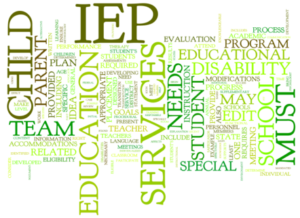
What is an IEP?
It can be torture to watch your child struggle in school, but you don’t have to be alone. There are federal laws in place to support your family in meeting academic milestones. Support is defined as either modifications or accommodations to the teaching curriculum.
Modifications are changes to what the student is taught. Examples include easier assignments, or not being expected to learn the same material. Accommodations are adapting how the student learns the material. Examples include having an assistant read the test to a student, or testing in a quiet room. Such changes can make the biggest differences in how your child learns.
What is it?
Under the federal law, Individuals with Disabilities Education Act (IDEA), public schools are required to create an Individual Education Plan (IEP) for every child receiving special education services. IEPs are designed to address learning styles and deficits.
It is a legally binding document written through team effort of a teacher, principle, and parents. Once it is agreed upon by all parties, the school must uphold the contract.
The IEP has several key components. First, an IEP will outline your child’s baseline level of performance through several assessments. Based on these scores, annual educational goals will be generated. The school must outline how they will best accommodate your child to reach these goals.
An IEP will outline any test taking modifications or accommodations needed. Each of these goals should be defined in clear, measurable terms. Finally, an IEP should include a transition plan, or terminal criteria.
Who needs an IEP?
All school age kids from kindergarten to graduation are eligible for an IEP. The maximum age for an IEP is 22 years of age. To meet eligibility criteria, your child must
- Receive an evaluation
- Qualify for special education by having one of 13 disabilities covered by the IDEA
These disorders include: Autism, deaf-blindness, deafness, emotional disturbance, hearing impairment, intellectual disability, multiple disabilities, orthopedic impairment, other health impairment (including ADHD), specific learning disability (including dyslexia, dyscalculia and dysgraphia), speech or language impairment, traumatic brain injury, or visual impairments.
What you can do?
When preparing for your IEP, don’t go through it alone. Involve your significant other or a close family member. Be sure to read up on your state and federal laws. These will be helpful when exercising your rights.
Below is a checklist to prepare for your first IEP meeting. This can be adjusted for future meetings as you become your own IEP expert!
Checklist for an IEP Meeting
Here is a checklist for “before, during, and after” your IEP meeting:
Before the meeting:
- Bring a partner. Try scheduling the meeting to accommodate your spouse’s schedule or ask a friend who knows you and your child. Bringing a family member is also a great idea. You may need to let the IEP team know who you are bringing, be sure to check. Establish roles before entering the meeting such as a note taking and speaker.
- Bring any additional reports. If you use any private services (OT, PT, psychologist, etc.) ask them to provide a report to include in your child’s files. These will be helpful in confirming or challenging any particular goal brought up in the IEP meeting. Be sure to review the reports prior to enter the meeting so they are fresh in your mind.
- Prepare. Prior to the meeting, consider your child’s strengths, interests, and what you think are his or her needs. Then prioritize the most important goals, skills, or strategies to implement or work toward for the child in the coming year. Consider strategies that work at home that you could suggest for the school environment. While we want much more for your child, by narrowing the focus, it helps all the team members stay on target. Think of the targets as steps. Where do you see your child at the end of the year? By next year? In three years?
During the meeting:
- Record the meeting. This may or may not be allowed, but is worth asking. This will allow both partners to be actively listening, and be able to review the meeting later. This is especially important for meetings that may be difficult. Your first meeting may be overwhelming.
- Additional assessments. Ask what other assessments the school district offers. Related services include occupational or speech therapy. Special factors are strategies or accommodations to aid in presentation of tasks such as augmented communication, audio presentation for visually impaired, or behavioral accommodations. Some districts have more resources than others, and it’s always helpful to ask.
- Measurable & realistic IEP Goals. The heart of the IEP will list specific educational goals for the child. Things to look for are goals that are objective and understandable. General goals such as, “Tom will be able to attend in the classroom with increasing frequency” are open to subjective evaluation. Rather, the goals should have clear and complete measurable definitions, such as: “Tom will be able to complete grade-appropriate class work during class time, up to 75% accuracy”. Also look how the goal will be evaluated, by the teacher? By an assessment? Who in the team is responsible for implementing and evaluating this goal?
- Ask questions and seek clarification. Be sure to be actively listening to each goal. The team has lots of experience in IEPs and may gloss over some special education laws and programs. If you hear a new term, be sure to ask for an explanation. Understand every detail and decision.
- Team. You are a specialist and an advocate for your child. At the same time, the team is working to achieve the same goals. Make sure you are all on the same page with every goal. Exercise your rights for your child while still respecting the limitations of the school. Everyone on the IEP team brings something to the table.
- Communication system. Be sure to establish a method for the teachers and parents to communicate. This could consist of pwritten daily logs, weekly emails or bi-weekly phone calls. This should be agreed upon in advanced so all parties are held accountable.
After the meeting:
- Review and sign by deadline. If they do not provide a report in advance, request to have 24 hours after the meeting to read the report before signing. Take your time and do not feel obligated to sign during the meeting. You should be sure you understand each goal. Make sure to keep a copy for yourself.
Resources
California Department of Education – Resources on IEPs for Children with Disabilities. Retrieved from: http://www.cde.ca.gov/sp/se/sr/iepresources.asp
Understood.org – IEP Boot Camp: Getting Ready for Your Child’s IEP Meeting. Retrieved from: https://www.understood.org/en/school-learning/special-services/ieps/iep-boot-camp-getting-ready-for-your-childs-iep-meeting
Wright’s Law –Individualized Education Programs (IEPs). Retrieved from: http://www.wrightslaw.com/info/iep.index.htm






